Upholding GDPR & UK-GDPR and Cookie Compliance 3 May 2023 12:11 PM (last year)
The General Data Protection Regulation (GDPR) is a data privacy and security law passed by the European Union (EU) which was put into full effect on May 25, 2018. The goal is to provide legal guidelines to protect the personal data of all EU people online. However, many other countries are following suit as they look at the GDPR as the next standard of personal privacy and data protection. For example, the United Kingdom (UK) has already adopted its own version of the GDPR called the UK-GDPR. This was done due to separating from the EU in December 31, 2021.
The GDPR, UK-GDPR and Cookie Compliance Explained for Businesses
Laws like the GDPR, UK-GDPR, CCPA/ CPRA are steps governments are taking to protect the personal data of its citizens. Personal data is information collected that may include things like IP address, location, contact info, ethnicity or any data which contains details that make a person individually identifiable. Under the GDPR, this applies to all websites, not just the websites owned in the EU. Those who ignore this law may face penalties reaching €20 million or 4% global revenues. This could be why over half of US based companies are making compliance a top priority, of which 77% are budgeting at least $1 million on GDPR optimization.
Was the “Cookie Law” Replaced?
The GDPR is NOT the ePrivacy Directive (EPD) or “Cookie Law” that was passed in 2002, but expands to data collection practices as a whole within the EU, rather than a focus on just tracking methods. Although in some areas the EPD may supersede the GDPR, one doesn’t replace the other.
Who Does the GDPR Apply To?
If You Process Data of EU Citizens: Any person or entity that processes data of or sells products to EU citizens or residents, falls under the GDPR rules. These regulations apply to any website around the world who handles or stores any personal or private data of those who live in the EU.
If You Are an EU Based Company: These regulations provide protection to ALL visitors to a website if the data controller (website owner collecting the data) is based in the EU. For example, a citizen of the United States is protected by the same law as a person who lives in the EU if the website owner is based in the EU.
In short, unless you plan to deny website access to ALL EU visitors online and hold no operations within EU countries, then the GDPR will apply to your website and business.
7 Principles of GDPR
- Lawfulness, fairness and transparency – People need to have the ability to know how their data will be handled and processing must follow established laws and fairness practices.
- Purpose limitation – A person’s data cannot be used for anything outside of what is specified.
- Data minimization – Only collect information necessary to accomplish the objective.
- Accuracy -personal records must be current.
- Storage limitation – Personally Identifying Information may be held no longer than how long it’s needed for processing.
- Integrity and confidentiality – Business must keep personal data secure and not share it unnecessarily without consent.
- Accountability – Any person who is collecting and processing personal data must show proof following these principles.
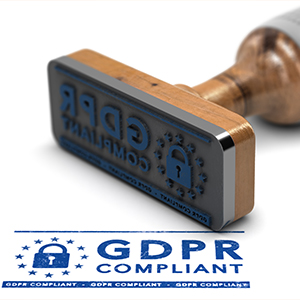
GDPR Website & Cookie Compliance
Despite its length, the GDPR only mentions the term “cookies” once within its 88 pages. According to the GDPR, any cookie that is not strictly for the functioning of your website AND collects personal data (EU) must be deactivated until users manually opt into those scripts being used.
There are four major types of cookies:
- Necessary Cookies. These cookies belong to the website’s owner and are needed to be active for your website to function properly. They usually only last as long as the session and don’t follow the user off the website.
- Preference Cookies. These remember the user’s settings like language and saving form information.
- Statistics Cookies. These are for third-party programs like Google Analytics that collect and measure data.
- Marketing Cookies. These allow for ad customization to be served based on the user characteristics like location and collect behavior and data to be sent back to the ads service for remarketing. Facebook and Google Ads make use of such cookies.
Under the GDPR and EPD, your website must allow visitors to choose which cookies to enable on your website. Only cookies considered “necessary” can bypass being opted out by the user. Your website must receive user consent before allowing any unnecessary cookies to run, provide clear and easy to read privacy policy, give ability to users to withdraw you consent, and ultimately, the ability to use your website regardless of opting into cookies. Below is more of this in detail.
How To Optimize Website for GDPR
- Create a Cookie Notification: Have a cookie notification through a banner or pop-up where visitors can opt-in to what cookies they want turned on. It is not allowed to have boxes pre-checked or assume users opt-in if they ignore the box. Any set of cookies that are NOT necessary must be actively opted-in by the user.
- Have a Cookie Policy: Within your notification, have links to your policy on your cookies and any third-party cookies like Google Analytics. Policy should explain the “what” and “why” about the cookies in use.
- Update Privacy Policy: Make sure your website’s privacy policy is current with a more detailed explanation about the cookie policy. It should mention how you collect and store data, as well as, what you do with the data. There should be contact information listed so users can get in touch with you on how to access, modify or delete their data. Include things like IP addresses are captured or tracked for specific purposes.
- Purchase SSL: If you don’t have one, then it would be worth getting one. It’s important because it secures data transfer between user’s devices and web servers, and it’s Google best practices. Plus, do you want to be that website that displays “not-secured” in the URL bar of a user’s browser?
- Capturing Leads: Don’t store any digital user information that is unnecessary. If you do, make sure that stored information is encrypted. Make sure your email service provider (Gmail, Yahoo, Hotmail, Outlook, etc) also has a GDPR policy in place as well. Lead information can be passed through email, so you want to be covered there. On lead forms, don’t pre-check any boxes like “terms & conditions” or “subscribe me to newsletter” on the form. If you print any digital copy with user information on it, shred it or dispose of it securely when you are finished with it. That cannot be left out.
- Third-Party Services: Make sure any third-party services that you use within your business and website have GDPR policies in place to protect you from being liable for violations. These services include payment gateways, cloud storage, website chat bots, analytics, email providers, or any other service which collects, stores, and processes personal data.
- E-commerce: Must delete or “cleanse” any personal information after a reasonable amount of time.
The Difference Between the UK-GDPR and the GDPR
The UK-GDPR (United Kingdom General Data Protection Regulation) took effect on January 31, 2020 alongside the Data Protection Act of 2018 and the PECR. Due to leaving the European Union on December 31, 2021, the UK was quickly drafted and accepted the UK-GDPR. The UK-GDPR is almost identical to the EU GDPR, except that it has changed to accommodate UK law rather than EU law.
Similarities Between the UK-GDPR and GDPR:
- Both require websites to obtain explicit consent from users before processing their personal data via cookies and third-party trackers.
- Both require storing and documenting each valid consent.
- Both require websites to enable users to easily change their consent.
- Both provide citizens the right to delete and correct already collected personal data.
- Both share core definitions like personal data, the rights of data subjects, controller, and processor.

Differences Between the UK-GDPR and GDPR:
- Although UK is now considered a “third-country” by the GDPR, the EU adopted an adequacy decision for the UK to allow free flow of personal data from individuals within the EU to the UK. However, the UK adequacy decision by the European Commission is limited to June 2025 and will not automatically renew.
- The Data Protection, Privacy and Electronic Communications (EU Exit) Regulation (DPPEC regulation) which was adopted by the UK. This document is what adapts the EU laws to the domestic UK laws, as well as revising the Data Protection Act of 2018.
- The UK-GDPR expanded and changed areas like National Security, Intelligent Services, and Immigration, which are outside the scope of the European GDPR.
- The leading data protection authority in the UK, the Information Commissioner, is the lead supervisor, regulator, and enforcer (ICO) of the UK-GDPR. In the EU GDPR, this role was assigned to the European Data Protection Board.
- The UK Secretary of State has been given powers to determine or revoke adequacy decisions on behalf of the UK-GDPR, without consulting the ICO.
- EU companies doing business within the UK will have to appoint a “natural or legal person established in the United Kingdom” to represent them.
- In the UK-GDPR, the age of valid consent is lowered to 13 years old in the UK. It’s 16 years in the EU.
Is GDPR and UK-GDPR Compliance Necessary?
GTo understand why taking these steps are necessary, you must first know the purpose of documents like the GDPR and UK-GDPR. These rules have been put into place by the government authorities to do as much as they can to eliminate data breaches of personal data by reducing the amount and frequency of data freely passing unsecured from place to place. It is also forcing transparency and accountability between businesses and people who use the business services.

Although it may seem like a hassle, following the GDPR and UK-GDPR regulations, along with cookie compliance, puts power of choice back into the hands of the end-user…the customer! In addition, it validates the businesses who take these steps as being more responsible and respectful of the privacy and protection of personal data. Additionally, what business wants to pay compliance penalties up to €20M ($28M) or 4% of its global revenue?
Is your ProductCart website GDPR compliant?
We are here to help you navigate through global website compliance to privacy laws like the GDPR and UK-GDPR. Let our professional automated services keep you legal and current with best practices. Contact us today for a free consultation!
*NOTE: This article is not professional legal advice, rather a summary of GDPR key points and its implications as it entails to websites and cookies. To ensure complete compliance, speak with an attorney certified in the appropriate areas of law for official legal counsel.
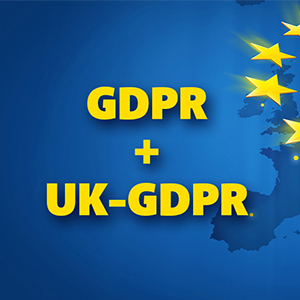
The post Upholding GDPR & UK-GDPR and Cookie Compliance appeared first on ProductCart Blog.
ProductCart and Mobile Responsive Design 15 Oct 2021 6:39 AM (3 years ago)
Your e-commerce website usability is vital for your website’s success! Shoppers need to be able to visit your website whenever the need arises, from whatever device they have available. Often times, the most readily available device is a cell phone. Due to this, a major topic during the website build conversation is mobile optimization and mobile responsiveness of websites. ProductCart customers should understand how mobile responsive design in a website’s theme is just as important as the e-commerce solution used to sell its products!
The Quick History of Mobile Responsive Design
As of the late 2000’s and 2010’s, more and more websites were designed to be “mobile friendly.” However, that isn’t the same as mobile responsive. A Mobile Responsive Design is defined as a website design that can be displayed on a mobile device and will automatically adjust its size, layout, and proportions in a legible way to fit the specific device you’re on. Basically, if you have a website, the code in the sites theme when built will decide if it automatically resizes and functions well on certain mobile devices…or not. A website’s theme is the framework of the site. It includes the layout and style of your website design. It’s the code used to create your website that provides the structure, style, and design of a website. All ProductCart designed sites are created to be mobile responsive, now.
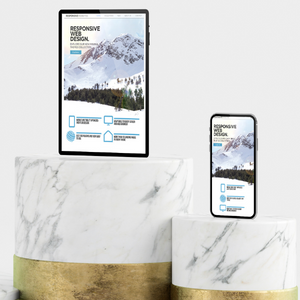
Over the years, the ProductCart team has followed best practices in web design to provide customers with an e-commerce store that has as much mobile functionality as possible. How a website displays in the mobile environment, on smart phones, tablets, and other small devices, is an also an important consideration for a site’s search engine ranking, or SEO ranking. Because mobile display is such an important factor for both customers usability and SEO value, it’s important to ProductCart!
Though ProductCart software works with mobile optimized websites, the software cannot make a site that is not currently mobile optimized, function responsively on mobile devices.
ProductCart Customers and Their Sites
So what does all of this mean for your ProductCart site or third party site with ProductCart software? Here are the details!
ProductCart Versions 5.0 and Beyond
In earlier versions of ProductCart – everything before the arrival of version 5.0 – mobile usability was provided through the use of a separate set of display files that were used when the site was accessed on a smart phone browser. The mobile display files were a limited approach, however, and required considerable additional work to correctly implement. All versions since ProductCart 5.0 – including the new v5.4 release – replace the mobile file set with a single display file set, or theme, that uses a mobile-responsive approach to the site design. Mobile-responsive design gives a single theme the ability to display accurately on a wide range of devices by using the popular Bootstrap framework as the basis for all user-facing pages.
But…and this is an important caveat, ProductCart’s use of a mobile-responsive design framework doesn’t mean that your website will magically become properly mobile-responsive just because you’re running version 5-whatever of the software. Think of ProductCart’s Bootstrap framework as ‘responsive design ready’ and you won’t be far off the mark. If your website’s theme is mobile responsive, an online store powered by ProductCart will render your website on mobile devices!

Mobile Responsive Design for Custom Websites with ProductCart
If you use one of ProductCart’s four standard Bootstrap themes, in a mobile environment the website will work properly without any more adjustments. For custom site designs, we recommend starting with the framework of the stock Bootstrap Clean theme and building out the customizations from that design core. You’ll want to make sure your site’s designer or developer has good working knowledge of both the general principles of mobile-responsive design and of the Bootstrap framework. Otherwise, even with the mobile-responsive capabilities built-in to the framework, you’ll end up with a site that doesn’t always display correctly across the full range of mobile devices and screen sizes.
Is your ProductCart website mobile optimized?
Was your website built recently? Is it mobile responsive? If you’re not sure, contact us! The ProductCart team can review your current ProductCart website or create a new one for the latest mobile optimized experience!
The post ProductCart and Mobile Responsive Design appeared first on ProductCart Blog.
ProductCart 5.4 Release Brings New Features 10 Aug 2021 1:31 PM (3 years ago)
Version 5.4 Upgrades and New Features
ProductCart continues its dedication to our customers and their success. With that in mind, we are proud and excited to announce the new features and updates with the release of ProductCart v5.4! This update makes our ecommerce software more user-friendly for both business owners and online shoppers.
Added Payment Method Option
While many payment options are already available with ProductCart, the popular Stripe payment method is also now included as a standard available payment integration in the version 5.4 update.
Page Speed and Performance
Another upgrade is re-factored code for faster page loading and search performance for both customer-facing pages and in the admin control panel. Admin pages also load in a more user-friendly manner and are easier to navigate through.
Promo Engine Addition
This is the “main course” of the ProductCart v5.4 update! Discount codes (coupons) and the sales manager have been replaced by an all-new functionality that allows clients more effective combinations of promotions. Our Promo Engine includes options for BOGO and Buy More, Save More discounts. With virtually no limits to the number of sales you can create in your ecommerce site you can wow your customers and have better control of offered sales and discounts than ever before!
Other new features in ProductCart 5.4 include:
- The ability for customers to send their shopping cart to others via email.
- Improved control panel pages to make better use of screen space for organization of information.
- New registration and log in layout to clarify use of advanced security CAPTCHA elements during the new registration and log in process.
- Google Tag Manager updates for the latest Google functionality.
- Enhanced customer account consolidation, which includes the ability to consolidate guest account information and orders under a single email address.
- Sales Tax API and Interface integration to save time and eliminate the hassle of managing tax tables for state sales tax requirements by automating the process (*subscription required).
- Notify your customers when an out-of-stock item is back in stock with an automated email.
Sound like we have what you need?
Whether you are interested in upgrading to the latest version of ProductCart, or are brand new to ProductCart and interested in all our new ProductCart v5.4 release has to offer—connect with our eCommerce experts today! We’re ready to get you started on your ProductCart journey to eCommerce success!
The post ProductCart 5.4 Release Brings New Features appeared first on ProductCart Blog.
How Apple’s iOS 14 is Impacting Facebook Ads 11 Jun 2021 12:08 PM (3 years ago)
Apple iOS 14 Updates and Your Facebook Ads
There are many moving parts in the mainstream media regarding apps, finance, the internet, and other related topics. A large spotlight has been put on Facebook and Apple’s rivalry over user privacy, policies, and how they impact one another. While media may speculate on the effects of these new changes, we have the need-to-know information and recommendations for Facebook ad techniques in the ecommerce and online retail industries.
About Facebook Ads, Apple, and User Privacy
- Facebook gathers and analyzes user activity while on their app to help target paid ads to relevant users, then shows those ads to the best matched user.
- Over the past few years, Facebook ads have also relied on user activity from other apps and websites to make their targeting more accurate.
- Apple users have been able to decline or “opt out” of sharing their data from outside sources on Facebook since the Apple iOS 10 update, released in September 2016.
Privacy Policy for Off-Facebook Activity
After installing the Apple iOS 14 update, users will receive notifications when opening the Facebook app for the first time post update. These notifications will ask the user if they will allow Facebook to see their “Off Facebook Activity”.
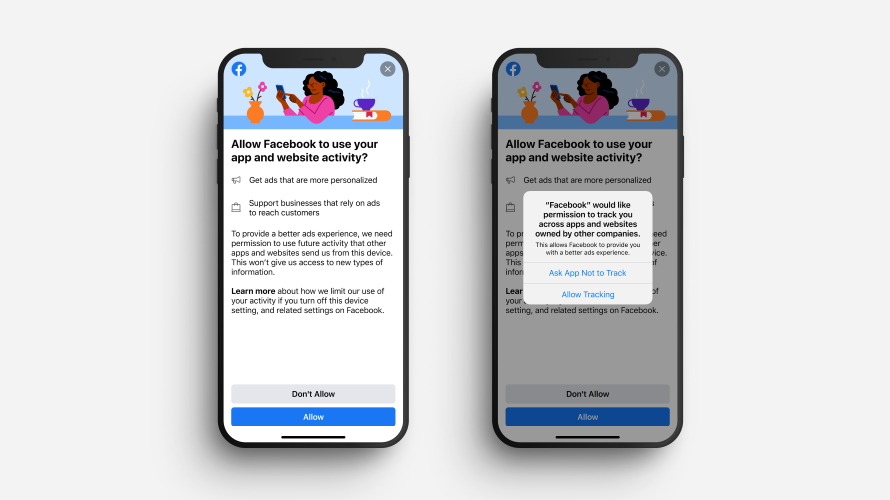
As the image above shows, one privacy notification will come from the Facebook app (left). The second will be a pop-up notification from your Apple device (right).
Both will ask you if you will allow Facebook to track user activity while using other apps and websites not owned by Facebook. Users can choose to not share activity from other apps with Facebook. However, this will not stop Facebook advertising from using your activity while on their apps for ad targeting purposes.
Apple iOS 14 Update Won’t Hurt In-App Facebook Advertising
The majority social media leads and conversions in most industries happen from ads seen while on the Facebook family of apps, like Facebook and Instagram. If users choose to not share their off-Facebook activity with the app, Facebook will not show that person paid ads while they are using other free apps. They will only see paid ads while on Facebook or Facebook-owned apps, such as Instagram and WhatsApp. Since most ecommerce websites don’t receive their conversions in third-party apps, this change is likely irrelevant.

Facebook Ads Reporting Numbers Will Only Appear Low
Ads seen while users are on the Facebook App or website will be minimally affected, if at all. If you are advertising in the app directly (marketplace or paid campaigns), your ads will still be seen by the same audience currently seeing them.
This is done through targeting in the Facebook advertising campaign manager. Users build an audience based on age, demographics, location, and interests of their target customers.
Facebook Ads Conversions Explained
An important step in the ad creation process is for the advertiser to define what actions they deem as successful from their audience. Successful actions are performed by a user seeing an ad is called a conversion.
Examples of conversions: clicking a link on an ad to visit a web page, filling out a form linked from the ad, visiting your website through a Google search within a certain time frame of seeing your ad (through a process called pixel tracking), seeing an ad and either searching for or purchasing a product or service on that business’ website.
Previously, Facebook reported a conversion if a user completed any of these types of actions within 28 days of seeing or interacting with an ad. Now, Facebook advertising reporting will only be able to report a user completing these successful actions within seven days of seeing or interacting with an ad. This does not mean you can’t get conversions after seven days, Facebook just wont be able to report that information to you.
What Does This Mean for Your Ecommerce Store?
Don’t let the news of this Apple iOS 14 update worry you. Facebook ads will be reporting less information, but this does not mean your advertising is any less effective! Plus, there are other reliable ways to track user actions and conversions from social media and Facebook advertising.
Google Analytics is a great tool that reports traffic coming from social media posts and other digital advertisements to your site. With proper tracking in your social media ads, your business can see how effective your Facebook ads are at getting leads to your retail site. The fact is, changes made by the Apple iOS 14 update likely won’t affect your digital marketing results.

NetSource Media social media specialists recommend following the statistics of your paid social media accounts and monitoring the results on Google Analytics. Our in-house marketing professionals manage all client accounts this way. We ensure our client ads are reaching prospects and successfully earning quality leads from these conversions. While Facebook ads and social media marketing techniques are ever-changing, our thorough management processes ensure our clients’ success.
Have questions about Facebook advertising, social media changes, or management?
Our social media experts at NetSource Technologies are here to help. We’ll stay up-to-date on the latest changes and implement our knowledge to help you growyour business through organic posting and paid Facebook ads.
The post How Apple’s iOS 14 is Impacting Facebook Ads appeared first on ProductCart Blog.
Call Tracking for Your Ecommerce Website 11 Jun 2021 9:46 AM (3 years ago)
Once upon a time, the phone numbers of every person known to us were kept in the archives of our minds. Phone numbers were another way to brand a business, but not anymore. With the invention of the smart phones, remembering phone numbers is no longer necessary. Using a call tracking phone number, or multiple numbers, your business can drill down to the details and find out which marketing efforts give you the most return on investment. In short, see what advertising brings in more quality leads and sales.
In addition to knowing how and where to advertise, using a call tracking phone number will also give you vital data on your customers and their habits. What does this do for your business? It allows tracking of the data provided from all incoming calls. This data will tell a business so many things.
- Where leads are coming from.
- How many conversions you’re getting by phone.
- Data showing what works for your target audience.
Diving Deeper into Call Tracking
Businesses often advertise through more than one medium at a time. With so many options in marketing, it’s important to know exactly which advertisements are bringing in the most leads, and eventually conversions. When something is successful, it makes sense to repeat it. Using a tracking phone number system will offer so much information that can be used for your benefit.

Origin of Incoming Calls
With call tracking, each medium used for advertising your business can have its own phone number. This could be paid advertising on a social media platform, through Google Ads, Google Search, your website, third party websites, or even other avenues of digital or print advertising. Since people don’t memorize phone numbers these days, using many different tracking numbers isn’t a problem…it’s a beneficial solution! Businesses can then see which advertisements are bringing in the most phone calls, even which ones bring in the most conversions.
When Call Volume is Highest
With call tracking, businesses can review what days and times leads are most likely to call and how long they speak to your sales team. You can be sure you’re adequately staffed when it’s most beneficial to your bottom line. Scheduling staff break times and even days off during slower times for business will be beneficial to your inquiring callers and your business. Have your staff prepared to answer the phone and sell products when your target buyers want to buy.

Measuring Call Time Averages
As leads call your ecommerce store, tracking how long calls last will provide insight into the quality of your sales team communication. Leads calling in are great. It is equally important that your staff is able to provide those leads with information that sells them on your ecommerce store by providing them with what they need. Online retail stores can be sure their staff members are communicating well with leads reaching out by phone.
Call Tracking Conversion Rates from Call to Sale
When a business finds certain actions successful to making sales, it’s important to be able to explain the actions and duplicate them repeatedly.
Here’s an example: If a certain advertising medium averages 10 incoming calls per week, and five convert to sales, that is a successful marketing effort. Let’s say another advertisement yields 20 incoming calls per week, but only one to two sales weekly on average. If both advertising options cost about the same, Option 1 is the more beneficial marketing solution for your bottom line. In the future, you will likely be more successful spending your marketing dollars and efforts with Option 1.
Tracking calls can help quantify this information and use it to your benefit. You can directly quantify all the conversions your business receives from incoming calls, then duplicate those actions and make more sales.
Is Your Digital Marketing Agency Working for You?
When using a third-party marketing agency or advertising firm, it is important to be able to show an accurate return on your investment. Call tracking phone numbers are an excellent way to do that. When a company provides an advertising service for your business, you’ll be able to report exactly how many leads they’ve been able to send your way. Then, you can find out how many of those leads turned into closed sales. Call tracking will provide a major insight on if your digital marketing agency is providing successful actions for your business.
NetSource Technologies has your Call Tracking Solutions
Whether you’re starting a new marketing plan internally or hiring a professional digital marketing agency to handle your lead generation and growth, tracking calls is a no brainer. It will allow your business to see all the ways your digital marketing is helping your business thrive, and all the ways it is not. For more information, contact NetSource Technologies today!
The post Call Tracking for Your Ecommerce Website appeared first on ProductCart Blog.
Lifestyle Content and Retail Websites on Facebook 11 Jun 2021 7:57 AM (3 years ago)
The idea of using lifestyle content to grow a business may seem irrelevant to sales. In the past, it has been ingrained in the minds of many businesspeople to push products, advertise sales, and deals on social media. Without breaking up your sales content, the overselling can lead to a decrease in your bottom line, making your ecommerce store or retail website less money. When users don’t interact with your page, social media giants like Facebook will hide your content from its users because your page looks uninteresting!
Using lifestyle content, whether you create it digitally or curate it at your retail store location or home-base, will engage social media users, giving you free exposure. Even if users aren’t ready to make a purchase now, they’ll remember your retail website when ready because Facebook will keep your page at the top of their News Feed.
Don't know where to start for social media strategy?
We will help you succeed in your marketing and help keep your business thriving for years to come. Let our Facebook Certified Marketing Professionals strategize for you. Get a FREE social media audit with strategic recommendations just for you.
What Is Lifestyle Content?
Before we go into the details of how lifestyle content is beneficial, it is important we define the phrase.
Lifestyle content tells a story with images or ideas related to real, everyday actions and scenarios. It is not selling you on a product, it is selling you on a lifestyle, or type of living.
Traditional sales-based content will revolve around features and function, as well as information on the items or services you sell. Lifestyle content is used to build a positive association in the minds of your prospective customers. It allows them relate to you, your staff, and your business on a personal level. Many retail websites and ecommerce stores discount the power of lifestyle posts, but that is a major mistake in today’s retail and sales markets. Another major downfall to not entertaining your social audience with relevant and positive posts is the fallout from social media platforms. If users are not interacting with your posts, your page will look uninteresting to your followers, and they will remove your content from the users News Feed.
Real Content Earns Exposure
Your leads want to know they are more than just another sale. No one wants to feel like another number, not even consumers. Consumers seek information that will benefit them. You can be the one to provide that information. However, you first must gain their trust. Once trust is earned, you can make the sale more easily.
Traditional sales-based posts showcase your products and services, newly stocked items, discounts, and more. Due to the flood of sales content consumers are exposed to daily, there is only so much sales-type content you can push before people start to lose interest. Additionally, at some point, growth on social media will become stagnant. Your followers will lose interest in seeing the same repetitive sales posts. They may even unfollow you because of the frequency of these posts. This is where real life content comes into play.
Types of Lifestyle Content for Retail Websites
Lifestyle content can be used across multiple digital mediums. It can be used in social media, blogging, and website content and branding. Pictures, videos, reviews, and shared information are all successful forms of lifestyle content. Using these to be more relatable to your target customer helps humanize your business, and provides them with entertaining or informational content. Branding is also an important practice. It is aimed at improving customer relationships by making your ecommerce store memorable and recognizable through your content.
Leads and customers feeling as if they know the “real” people behind your business builds trust. With proper branding and use of lifestyle content, your business will represent a positive experience to consumers. This makes them more likely to buy from you, not the other guy.
Organic Social Media Posting Matters!
A simple and free way to introduce lifestyle content into your social media marketing strategy is to create it yourself! Take pictures of happy clients post-purchase or ask for pictures from your buyers using the product purchased from your online retail store in their everyday life. Content of yourself or your staff members performing “behind the scenes” work at your business also makes great lifestyle content. Consumers want to know their purchase process will be simple, easy, and enjoyable, not dread the experience.
Post these pictures and videos on your social media pages in between your usual sales and information posts to break up your content. People following your social pages will be less likely to click the “unfollow” button if they see content they find relevant. Since not every follower is looking to buy your product right now, lifestyle content is the perfect way to stay relevant with everyone!
Lifestyle content keeps followers engaged without feeling like they’re constantly being sold something. In addition, if you don’t share organically on your social media pages, you will likely be removed from your follower’s news feed. Even if you pay for social media ads, your exposure will still be limited. When users are not interacting with your posts daily, the computers crawling social media will think your followers are not interested in your content. This is how your business gets removed from the viewers news feed.
Make your marketing an investment in your future!
Social media giants have confirmed they will continue to make changes to their platforms. No matter how much you spend on advertising, you will still be hidden if you don’t post organically. You don’t have to go at this alone. For more information on how to beat Facebook’s algorithm changes and stay relevant, contact a Marketing Specialist today. We’re here to make your marketing successful!
Retail Blogging
Creating a blog for your business is a beneficial way to start creating your own lifestyle content. By creating content yourself, you control the image of your retail website. This gives you a way to connect with your audience and give them useful information that will benefit them in their current or future ownership of your product. Your audience will see your business as a trusted source for information and education, building faith in your brand.
By not constantly selling your products to your audience, you are selling them on your reliability. Showing your future customers you’re a real person who understands their wants and needs often goes much further in making the sale than a discount or sale price. Most consumers that feel respected and understood are more likely to choose your retail website for their next purchase.
Branded Website Content
Lifestyle content shouldn’t be use sporadically. Showing consistency and dedication to the way consumers see your ecommerce brand is key to being believable. Using lifestyle-type branded content on your website shows dedication to your consumers view of your retail website.
Previous buyers want to know you are the same now as when they first purchased from you years ago. New buyers want to know you are the same now as when the person who referred them purchased from you. Show website visitors your retail site’s number one priority is buyer satisfaction year after year through your branded lifestyle content.
Humanize Your Brand with Real Content
As an ecommerce store owner, you are fully aware of all the awesome and fun benefits to owning your product. You see happy customers enjoying their new purchase day in and day out. Your potential customers don’t, so it’s your job to show them. Sell your future buyers on real life benefits of owning your products. Show consumers that you understand their needs and are the trusted business owner who can provide them with exactly what they want and need through lifestyle content.
No matter your ecommerce store size, using real-life content is a tried and true way to get you on an upward path! If you are still curious and want to learn more, reach out to one of our social media experts today and learn even more about how you can use social media to grow your brand and your bottom line!
Make more sales with branded lifestyle content!
No matter your dealership size, lifestyle content is a tried and true way to get you on a consistent upward sales path. Learn more about how lifestyle content can help you sell more, without pushing sales. Grow your dealership brand and your bottom line!
The post Lifestyle Content and Retail Websites on Facebook appeared first on ProductCart Blog.
How to Drive More Sales with Better Images 10 Oct 2019 10:00 PM (5 years ago)
It goes without saying that many consumers shop with their eyes. Sure, reviews left by people who already purchased the product are brutally honest and sometimes ruthless. But what closes the sale can often be the quality of the photo for the product you’re looking at and the sheer quantity of photos taken at different angles to see every square inch before you buy.
For those who sell their products online (nearly everyone) that shell out for the best photographer, they can get their hands on and know the importance of a good, high-quality image, move on to the next article. For the remainder of you, right here is where you want to be. Let us explain.
In 2019, the average attention span of an adult is 12 seconds. For millennials, (the ones who make up most of eCommerce shopping and sales) it’s a mere eight seconds. That means you have between 8 and 12 seconds to convert a consumer into a customer before they move on to your competitor that has the same product in a higher quality image.
Humans also tend to form opinions and impressions within seconds. This, again, tells you that you must show rather than tell the consumer that it’s your product that’s worth buying. Put your consumer shoes on and think about it. If you’re trying to find the best set of bedsheets on Amazon, are you going to choose the one with only one, blurry photo? Even if they are the best set, you probably still won’t buy them.
So, what actions can you take to drive more sales with better images?
Choose high-quality images.
Honestly, your website won’t be taken seriously enough if you have low quality, blurry, tiny images to showcase your merchandise. Even if they do show up high in search results, shoppers won’t be inclined to click on them, because nobody clicks on a blurry photo. Choose photos based on who your audience is and what their needs are rather than your preferences. Be sure the background is simple, the product you’re selling is the main focus and is NOT blurry, and isn’t too dark or too light. Also, be sure to show your product in as many angles as necessary.
Upload multiple images.
You have to build the customer’s trust, and there is data supporting the link in more images to higher sales. Having more images uploaded to show your product won’t leave any questions unanswered, and will help keep the buyer’s attention, as most people do scroll through all images available. The images are the closet the customer can get while shopping online. Say you’re selling a pair of shoes. You’ll want to include angles that display the shoe from each angle so the customer can see the side, the bottom, the top and inside the shoe. Think about it. You’re more than likely going to click on one website over another if it has more images. By the seller showing everything about the product, they’re saying they believe in it, and they hope you will, too.
Upload larger images.
Research shows people are more likely to buy a product that has larger images on display. This means the images are high quality enough to zoom in over each image for the customer to simply inspect each aspect of the product. This also makes the customer more in control of their decisions as they are able to interact on a higher level.
Add lifestyle photos into the mix.
If you choose to include lifestyle photos, you’ll drive more sales because the consumer will picture themselves using the product. Let’s say your product is a nonstick skillet. You’ll want to use photos of someone using that skillet in several different ways, like scrambling eggs, flipping pancakes, and maybe even someone washing it to show it’s easy to clean. The point is that if you simply upload a few photos of the skillet with a white background and nothing else, it won’t look user-friendly and the shopper won’t see how versatile is it.
If your product has different uses, show them.
Let’s say you’re selling a scarf that can be worn eight different ways. Instead of showing just one way, you’re better off showing each way it can be worn. The idea is you’re telling the shopper they’re getting a great deal and they’ll only ever need this one scarf because of its versatility.
Crop your images in closely.
As a general rule, you want your product to take up most of the canvas. Your customer isn’t shopping for a white background, so crop in the image as close as you can. And while we’re talking about backgrounds, as long as it’s not a lifestyle shot, keep it a simple white for fewer distractions.
Use keywords for each photo.
This doesn’t necessarily help with having a better photo, but it will help drive sales. Many SEOs upload their photos using the image name that came from the camera (IMG_001.JPG). By changing the name to, let’s say, “blue-bedsheets-500-thread-count,” your page has a better chance of showing up higher in the rank. The consumer might type that into the search bar. Not IMG_001.JPG. Use specific words that will help Google better understand what the photo is, and you’ll rank better.
Now that you’ve got some background on why better images increase sales, take these tips and ideas and apply them into your next photoshoot or update your current photos on your website. It’s not about having the best industry software and technology, it’s about asking the right questions that will get you to the right conclusion. You must ask yourself how to gain the consumer’s trust, and then your sales will increase.
The post How to Drive More Sales with Better Images appeared first on ProductCart Blog.
Why Up-Selling & Cross-Selling Are So Important to Your Ecommerce Success 18 Apr 2019 10:00 PM (6 years ago)
If you’re an eCommerce business, you’re always focused on getting as many customers as possible. To get the sale, you employ a variety of marketing tactics to bring attention to your website. It’s exhausting to bring in anyone who has even a slight interest in buying a product. More importantly, you need to entertain and engage the loyal customers who buy frequently. What if there was a way to get the sales you need from fewer customers?
The tactics of up-selling and cross-selling are sure to increase your sales easily. Both methods will help you get more buys from customers who have bought from your business before or want to add something else to their cart. The following are explanations of each strategy and why they’ll work for your eCommerce.

Up-Selling
Up-selling is intended to encourage customers to buy a more expensive or premium version of something they bought, which is in the same product grouping. It’s important to consider your customers’ needs whenever you are up-selling, because offering a product that is completely outside of their price range will not work. If you offer a different version of what they want with slightly more expensive modifications, then you might convince them to upgrade to something that accommodates all of their wishes.
Cross-selling
The strategy of cross-selling is to sell additional or add-on products that work with a customer’s initial purpose. For example, if someone orders a mattress, you could try to sell them bed sheets in addition. Protection plans and guarantees are also an effective cross-selling tactic. It’s a great way to get visitors to add more to their cart once they get to the checkout page.
How to Use Them
Now that you’re familiar with the concepts of up-selling and cross-selling, you’ll be ready to successfully implement them in your eCommerce marketing strategy. Make sure you consider these suggestions when you use these selling techniques.
- Don’t Oversell. It’s great to include a few product suggestions for whoever visits your website. However, customers are often annoyed if you throw products at them left and right. Make sure your product cart is still simple to go through and includes only a few steps or else your customer might get annoyed and not buy anything. Use these tactics in moderation to pique a customer’s interest.
- Provide Deals for Bundles. If you’re cross-selling or up-selling, your customers will be more inclined to buy multiple items if they get a great deal. Offer a discount for purchasing however many products. You’ll still be making more money while encouraging your clientele the spend at least the minimum amount for a deal. Bundles help both the customer and the seller because the customer gets everything they need and more and the seller receives a better return.
- Get to Know Your Customers. Tracking your customers’ order history is an essential component of cross-selling and up-selling. If you don’t know what someone is interested in, then how can you show them the products they would be likely to buy? Put analytics and a tracking system into place so you have access to each client’s data. That way, your sales strategies will be easy to perfect and personalized for every customer.
Do you need help starting your eCommerce sales plans? Feel free to reach out to us at ProductCart and give us a call at (800) 401-0353.
The post Why Up-Selling & Cross-Selling Are So Important to Your Ecommerce Success appeared first on ProductCart Blog.
Super-Charged Online Marketing Strategies 7 Apr 2019 4:00 PM (6 years ago)
An eCommerce company is nothing without a stellar marketing strategy. With all of your services online, it’s important that you understand the nuances of online communication and how to best market your business to consumers who occupy these channels. You can do several simple things to maintain an online brand, including making a website, publishing newsletters, and having a social media presence. If you need to up your online marketing plan, follow these strategies:

Great Web Design
When you consider the concept of marketing, a website might not come to mind as an important tool to drive sales, but it’s actually one of the greatest marketing mechanisms. Getting the design of your website right will definitely improve all of your marketing efforts. There’s no point in spending all of your money on marketing if your site is messy and unappealing. When you direct traffic to your website, your potential customers should be immediately impressed. That’s why it’s essential to invest in a quality eCommerce site, and you can do so by hiring a consultant.
Search Engine Marketing
One of the simplest ways to find a business is through Google or another search engine. That’s how most customers connect with eCommerce businesses, so it matters what page your link is on in the search results. To get to the top of the pyramid, you need to establish Search Engine Optimization (SEO) practices for everything you do. By adding keywords and phrases and committing to PPC campaigns, you’re sure to land on the first page of a search. If you need help optimizing your online content, be sure to get in touch with an SEO Expert to help you through the process.
News and Events
A huge part of having an online presence includes updating your visitors with relevant content and announcements about your business. A great way to market yourself is by starting a blog or a section on your website dedicated to press releases. Adding this content to your site doesn’t just keep your business in the present, but it updates potential customers about any special promotions or events that they might want to be a part of. To start your own dedicated blog, contact an online marketing specialist.
Ready to pinpoint your online marketing strategy? Learn more about ProductCart’s capabilities here.
The post Super-Charged Online Marketing Strategies appeared first on ProductCart Blog.
New Website Launch: Mini Excavator Parts 31 Mar 2019 10:00 PM (6 years ago)
We at ProductCart are proud to announce our most recently website launch. Mini Excavator Parts by Pentom Supply Company has launched their custom ProductCart shop and we could not be more pleased with how this project turned out.

Custom ProductCart Website Design
Our experienced designers were able to create a completely custom design for Mini Excavator Parts. Featuring a beautiful edge to edge design, this custom website stands apart from the crowd. Not only is the new design beautiful, it is also functional as well. Designers created larger product images, as well as incorporated an easy to use navigation system. Making it easy for users to navigate the website is of the upmost importance, and something we strive to implement on every single one of our ProductCart websites.
Our custom websites are also SEO optimized. An SEO optimized site helps a business rank higher in Google and get seen by more people.
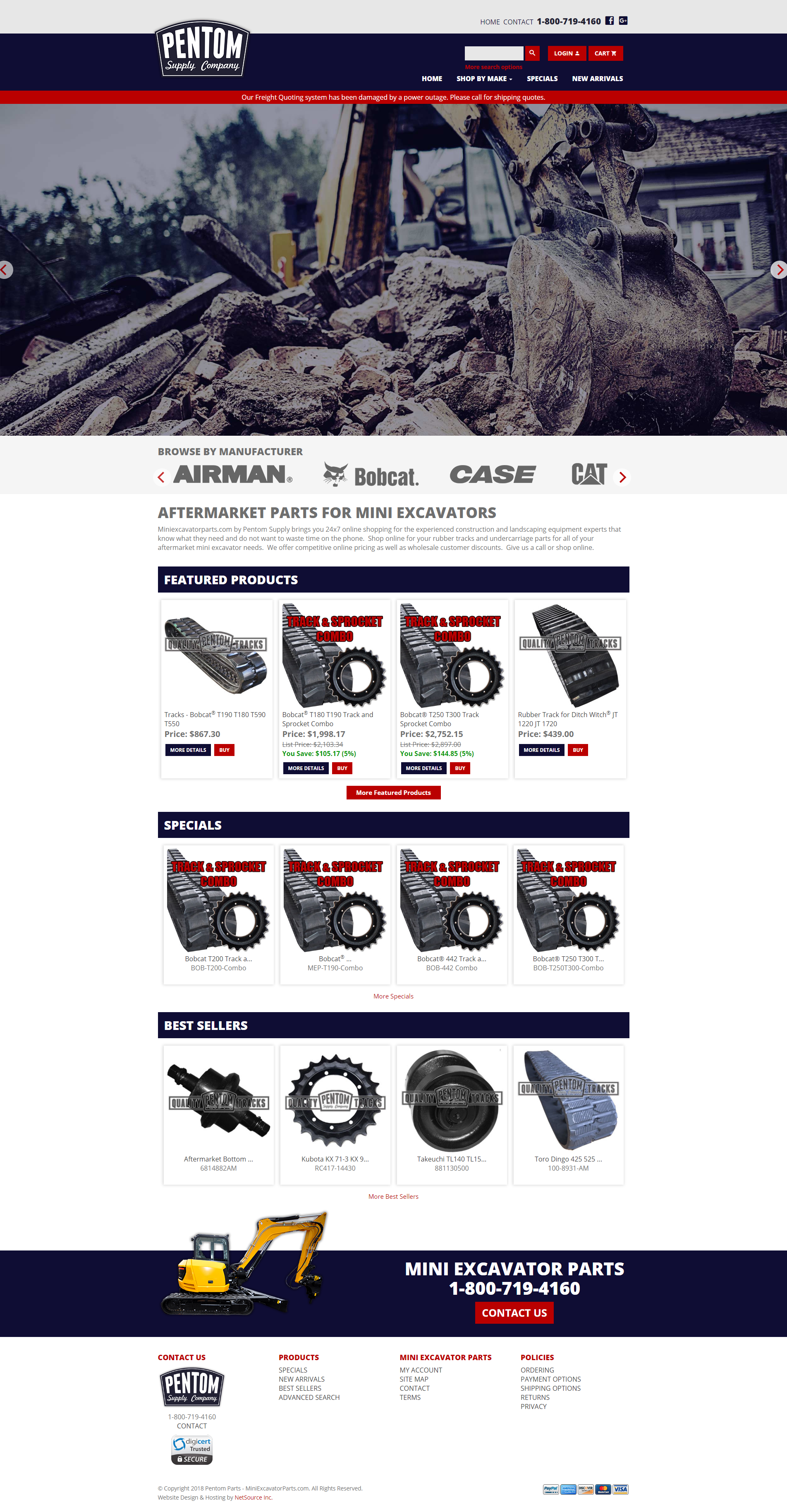
So if you want your site to be clean, beautiful, easy to search and user friendly; Contact one of our professional designers at ProductCart today and let us help you grow your business!
The post New Website Launch: Mini Excavator Parts appeared first on ProductCart Blog.


